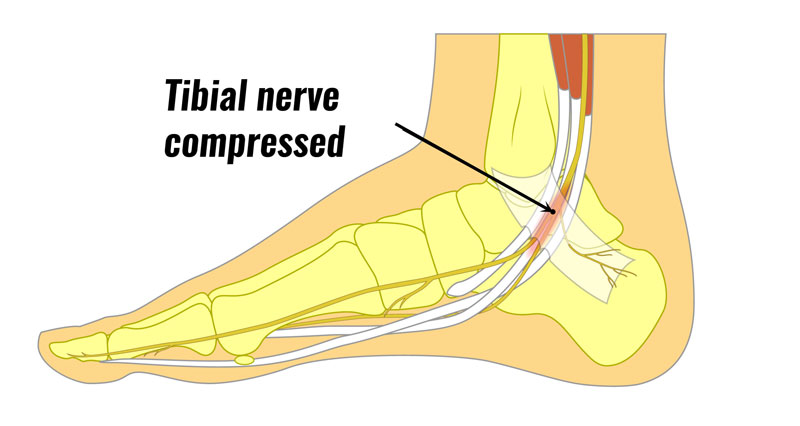Tinel’s test for the ankle assesses nerve irritation or compression. In particular with the tibial nerve and its branches in the lower leg and foot.
How to perform tinel’s test for the ankle
The patient should sit or lie down with their ankle and foot easy to reach.
First, locate the tibial nerve. Feel along the inner side of the ankle, just behind the bony bump or medial malleolus.
Then, lightly tap or percuss the path of the tibial nerve with your fingers or a reflex hammer. Starting from behind the medial malleolus and moving down the inside of the ankle.
Watch for the patient’s reaction. Specifically, a positive Tinel’s sign might occur, which includes tingling, pins and needles, or shooting pain along the tibial nerve path into the foot or toes.
A positive Tinel’s sign in the ankle suggests nerve irritation or compression. This may be from conditions such as tarsal tunnel syndrome or entrapment neuropathies. However, always combine these test findings with other clinical information and diagnostic tests. This ensures a thorough assessment and more accurate diagnosis.
Anatomy

The tibial nerve passes along a passage called the tarsal tunnel, just below the medial malleolus. When the tarsal tunnel narrows, for example when you tap on it whilst performing Tinel’s test, it reproduces symptoms.
Tinel’s test and the tibial nerve
The tibial nerve is one of the major nerves in the human body. It is primarily responsible for innervating the posterior compartment of the leg and foot. It is a branch of the sciatic nerve.
The tibial nerve travels down the back of the leg, running alongside the posterior tibial artery. Then it passes through the tarsal tunnel. This is a fibro-osseous canal on the medial side of the ankle. From here it divides into several branches that supply different muscles and areas of the foot.
It enables movement of several muscles in the posterior compartment of the leg. These include the gastrocnemius, soleus, plantaris, and muscles of the deep posterior compartment. It also provides sensory innervation to the sole of the foot and the posterior aspect (back) of the leg below the knee.
Motor functions of the tibial nerve include plantar flexion of the foot (pointing the toes downward), inversion of the foot, and flexion of the toes. Sensory functions include providing sensation to the sole of the foot and the skin on the posterior aspect of the leg.
Tibial nerve injury
Damage or compression of the tibial nerve results in symptoms such as weakness moving the foot, altered sensation in the sole of the foot, and difficulty walking. Common conditions affecting the tibial nerve include tarsal tunnel syndrome and neuropathies associated with conditions like diabetes.
Understanding the anatomy and function of the tibial nerve is important for understanding how Tinel’s test works.







